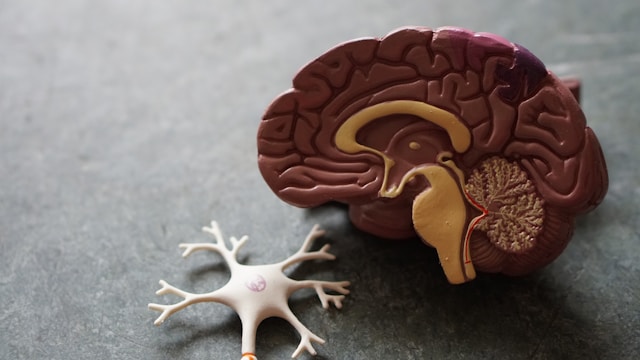Peptides for Improved Cognitive Performance
Do you plan to improve your mental performance and cognitive skills?
Peptides represent one of the top emerging compounds that boost brain function and protect against cognitive decline. Research reveals that these potent amino acid sequences demonstrate significant promise in enhancing memory as well as concentration abilities.
And here’s the thing…
Many people overlook the fact that specific peptides directly affect brain activity and can deliver advantages beyond what traditional supplements provide.
Scientific investigations reveal that multiple peptides possess the capability to traverse the blood-brain barrier and affect cognitive neural networks. Recent investigations demonstrate that targeted whey peptide supplementation enhances cognitive abilities in older individuals by improving associative learning and selective attention.
Researchers are discovering more about peptides which increases market growth through understanding their mechanisms and potential uses. Research findings demonstrate enhanced potential for these compounds to affect multiple brain function domains as our knowledge of neurochemistry develops further.
The rising curiosity about cognitive enhancement leads numerous individuals to investigate which compounds yield genuine performance improvements. The peptide supplement category possesses significant scientific validation as compared to other supplement types. Even better, when properly sourced from quality manufacturers creating premium peptides that prioritize purity and effectiveness, these compounds may offer a range of cognitive benefits without many of the drawbacks associated with traditional stimulants.
What You’ll Discover
- This section answers the question of what peptides are and explains their mechanism of action.
- Top Peptides for Cognitive Enhancement
- Science-Backed Benefits for Brain Function
- How to Incorporate Peptides Into Your Regimen
- Potential Side Effects and Considerations
This section explores the nature of peptides and their functional mechanisms.
Peptides consist of amino acid sequences connected by peptide bonds. Peptides function as miniature proteins which execute specific roles within the human body.
Peptides have unique brain function benefits because they can perform specific actions within the brain.
Peptides differ from many supplements because they can:
- Cross the blood-brain barrier
- Directly modulate neurotransmitter systems
- Peptides can initiate the formation of new brain cells through neurogenesis.
- Reduce neuroinflammation
Understanding peptides requires knowing they function as biological signaling molecules. By attaching to cell surface receptors they trigger precise cellular responses which functionally directs cells to execute specific activities.
These peptides hold potential for cognitive enhancement by affecting memory formation together with focus improvement and mental clarity and mood regulation.
The 2024 study revealed that the synthetic peptide PHDP5 successfully reversed cognitive decline in mice with Alzheimer’s-like symptoms which indicates a strong potential for peptide-based cognitive health treatments.
Top Peptides for Cognitive Enhancement
Research indicates that some peptides demonstrate stronger potential to improve brain power than others. The following discussion highlights specific peptides which research indicates can improve cognitive function.
Cerebrolysin
The medical preparation known as Cerebrolysin consists of neuropeptides sourced from pig brain tissue. Some countries utilize this treatment for conditions like stroke and traumatic brain injury as well as dementia.
The multi-modal action of this substance stands out as its interesting feature.
- Mimics the effects of neurotrophic factors
- Protects neurons from damage
- Promotes neuronal growth and connectivity
Research indicates that Cerebrolysin enhances cognitive abilities in individuals suffering from mild to moderate Alzheimer’s disease along with vascular dementia.
Semax
Semax represents a synthetically produced peptide that originates from ACTH (adrenocorticotropic hormone). The compound was first created in Russia and researchers have since investigated its effects on numerous neurological disorders.
Semax appears to:
- Increase BDNF (Brain-Derived Neurotrophic Factor) levels
- Enhance attention and memory
- Protect neurons during oxygen deprivation
- Improve blood circulation in the brain
Studies indicate that Semax improves focus and memory while enhancing cognitive abilities especially when under stress.
Selank
Selank represents another synthetic peptide developed in Russia alongside Semax. This substance is recognized for offering both anti-anxiety benefits and cognitive enhancement abilities.
Selank has been shown to:
- Reduce anxiety without sedation
- Improve learning and memory
- Modulate immune system function
- Optimize neurotransmitter balance
Selank offers a promising solution for people who experience cognitive performance issues because of anxiety or stress.
Noopept
Noopept functions as a dipeptide derivative which makes it distinct from pure peptides yet remains significant due to its cognitive enhancement effects. Research indicates that the substance boosts memory formation capabilities while increasing NGF and BDNF levels as well as offering neuroprotection which leads to improved logical thinking abilities.
Science-Backed Benefits for Brain Function
Although research into cognitive-enhancing peptides continues to develop new findings emerge that show multiple important benefits.
Enhanced Memory Formation
Multiple peptides show beneficial effects on memory formation and retention processes. The process involves elevating neurotrophic factors which help both develop and sustain the neurons responsible for memory processing.
A study from 2019 showed that whey peptide supplements improved associative learning capabilities in older adults which indicates these compounds could support memory function throughout aging.
Improved Focus and Attention
Peptides possess the potential to help you stay focused while completing tasks. Our constantly distracting world benefits from this ability to improve concentration.
Individuals who use specific peptides find they maintain concentration for extended periods without experiencing the jittery sensations or energy crashes typical of stimulant use.
Neuroprotection
The primary benefit of specific peptides lies in their capacity to shield brain cells against both damage and degenerative processes.
Studies in 2024 revealed that synthetic peptide PHDP5 dramatically lessened neural damage in Alzheimer’s disease models which suggests its ability to boost typical cognitive functioning and possibly prevent cognitive deterioration.
Neuroplasticity Enhancement
Neuroplasticity describes how your brain can create new neural pathways while adjusting to changes. Research has demonstrated that multiple peptides can enhance neuroplasticity.
These peptides assist in brain adaptability because they enhance neuroplasticity which allows better learning of new information and skills.
Mood Regulation
Several users experience mood enhancement after using specific peptides. Their impact on neurotransmitter systems which regulate mood explains these effects.
Enhanced mood states indirectly boost cognitive abilities because they correlate with better learning outcomes and memory retention.
How to Incorporate Peptides Into Your Regimen
For those who want to learn about peptides aimed at boosting cognitive function here’s a straightforward method:
Research and Education
Before trying any peptide, thoroughly research:
- The specific peptide you’re interested in
- Proper dosing protocols
- Legal status in your jurisdiction
- Potential interactions with medications
Educational knowledge serves as the strongest defense to prevent negative outcomes and avoid disappointment.
Consult Healthcare Professionals
A knowledgeable healthcare provider should be consulted before beginning any peptide treatment. This is especially important if you:
- Take prescription medications
- Have existing health conditions
- Are pregnant or nursing
- Have a history of mental health issues
Your healthcare provider can evaluate whether peptide treatment is suitable for your specific needs.
Source Quality Products
The lack of regulation in the peptide market requires strict quality control measures. Look for providers that:
- Offer third-party testing results
- Provide certificates of analysis
- Have positive reviews and a good reputation
- Clearly state purity levels
Suppliers display vast differences in quality standards and purity levels remain essential for ensuring both safe and effective peptide use.
Start Low and Go Slow
Begin every peptide regimen by taking the minimum effective dose and monitor your response closely. A cautious strategy effectively reduces potential risks while determining the most suitable dosage for your biological system.
Potential Side Effects and Considerations
Peptides have better safety profiles than many pharmaceutical treatments but there are still possible disadvantages.
Known Side Effects
The regular side effects associated with cognitive-enhancing peptides might consist of:
- Headaches
- Fatigue
- Dizziness
- Nausea
- Injection site reactions (for injectable peptides)
These effects remain mild and short-lived but require attention.
Long-Term Considerations
The medical community lacks comprehensive documentation of long-term effects because many peptides have only recently become widespread. Consider:
- Cycling on and off to prevent tolerance
- Regular health check-ups when using peptides long-term
- Staying updated on emerging research
These compounds are relatively new which requires continuous monitoring.
Regulatory and Legal Status
Peptide regulations differ across various countries. Before buying or using any peptide check its legal status in your area because some of these substances require a prescription or are regulated.
Wrapping It Up
The exploration of peptides stands as one of the most promising areas for cognitive enhancement research. Their fundamental brain function manipulation abilities grant them potential advantages that surpass those of typical nootropics.
Proper research combined with quality sourcing and professional guidance enables peptides to support enhanced memory functions and better focus while protecting against cognitive decline and improving mood alongside brain health support.
Peptides achieve maximum cognitive enhancement results when integrated into a well-rounded program that emphasizes quality sleep and regular physical activity along with proper nutrition and stress control.
The field of research continues to progress so it is important to keep updated with recent developments in order to make informed decisions about integrating peptides into your cognitive enhancement plan.







![Afinil.EU Online Pharmacy Review: Reliable Supplier of Medications in Europe [95% Cheaper] Afinil.EU Online Pharmacy Review: Reliable Supplier of Medications in Europe [95% Cheaper]](https://curiousmindmagazine.com/wp-content/uploads/2025/02/154-640x412.webp)


